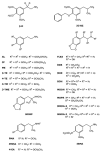MDMA (3,4-Methylenedioxymethamphetamine) Analogues as Tools to Characterize MDMA-Like Effects: An Approach to Understand Entactogen Pharmacology
- PMID: 24403876
- PMCID: PMC3763760
- DOI: 10.2174/1570159X11311050007
MDMA (3,4-Methylenedioxymethamphetamine) Analogues as Tools to Characterize MDMA-Like Effects: An Approach to Understand Entactogen Pharmacology
Abstract
Besides stimulants and hallucinogens, whose psychotropic effects are shared by many structurally related molecules exhibiting different efficacies and potencies in humans, the phenylisopropylamine MDMA (3,4-methylenedioxymethamphetamine, XTC, "Ecstasy") is the prototypical representative of a separate class of psychotropic substance, able to elicit the so-called entactogenic syndrome in healthy humans. This reversible altered state of consciousness, usually described as an "open mind state", may have relevant therapeutic applications, both in psychotherapy and as a pharmacological support in many neuropsychiatric disorders with a high rate of treatment failure. Nevertheless, a comprehensive and systematic exploration of the structure-activity relationships associated with entactogenic activity has remained incomplete and controversial, highlighting the possibility that MDMA might represent a pharmacological rarity in the field of psychotropics. As the latter is still an open question, the pharmacological characterization of MDMA analogues remains the logical strategy to attempt the elucidation of the structural requirements needed to elicit typical MDMA-like effects. Intriguingly, almost no experimental evidence supports the existence of actual MDMA analogues that truly resemble the whole pharmacological profile of MDMA, probably due to its complex (and partially not fully understood) mechanism of action that includes a disruption of monoaminergic neurotransmission. The present review presents a brief summary of the pharmacology of MDMA, followed by the evidence accumulated over the years regarding the characterization of classical structurally related MDMA analogues in different models and how this state of the art highlights the need to develop new and better MDMA analogues.
Keywords: Behavior; Ecstasy; Entactogens; MDMA analogues; Psychotropics; monoaminergic neurotransmission..
Figures



Similar articles
-
Methylenedioxymethamphetamine is a connectogen with empathogenic, entactogenic, and still further connective properties: It is time to reconcile "the great entactogen-empathogen debate".J Psychopharmacol. 2024 Aug;38(8):685-689. doi: 10.1177/02698811241265352. Epub 2024 Jul 28. J Psychopharmacol. 2024. PMID: 39068642 Free PMC article. Review.
-
Beyond ecstasy: Alternative entactogens to 3,4-methylenedioxymethamphetamine with potential applications in psychotherapy.J Psychopharmacol. 2021 May;35(5):512-536. doi: 10.1177/0269881120920420. Epub 2020 Sep 10. J Psychopharmacol. 2021. PMID: 32909493 Free PMC article. Review.
-
Behavioral profiles in rats distinguish among "ecstasy," methamphetamine and 2,5-dimethoxy-4-iodoamphetamine: Mixed effects for "ecstasy" analogues.Behav Neurosci. 2010 Oct;124(5):662-76. doi: 10.1037/a0020827. Behav Neurosci. 2010. PMID: 20939666
-
Constructing the ecstasy of MDMA from its component mental organs: Proposing the primer/probe method.Med Hypotheses. 2016 Feb;87:48-60. doi: 10.1016/j.mehy.2015.12.018. Epub 2015 Dec 23. Med Hypotheses. 2016. PMID: 26826641
-
Aromatic Bromination Abolishes the Psychomotor Features and Pro-social Responses of MDMA ("Ecstasy") in Rats and Preserves Affinity for the Serotonin Transporter (SERT).Front Pharmacol. 2019 Feb 28;10:157. doi: 10.3389/fphar.2019.00157. eCollection 2019. Front Pharmacol. 2019. PMID: 30873030 Free PMC article.
Cited by
-
Treatment of Posttraumatic Stress Disorder: A State-of-the-art Review.Curr Neuropharmacol. 2024;22(4):557-635. doi: 10.2174/1570159X21666230428091433. Curr Neuropharmacol. 2024. PMID: 37132142 Free PMC article. Review.
-
Acute Effects of the Novel Psychoactive Drug 2C-B on Emotions.Biomed Res Int. 2015;2015:643878. doi: 10.1155/2015/643878. Epub 2015 Oct 12. Biomed Res Int. 2015. PMID: 26543863 Free PMC article.
-
Aromatic Bromination Abolishes Deficits in Visuospatial Learning Induced by MDMA ("Ecstasy") in Rats While Preserving the Ability to Increase LTP in the Prefrontal Cortex.Int J Mol Sci. 2023 Feb 13;24(4):3724. doi: 10.3390/ijms24043724. Int J Mol Sci. 2023. PMID: 36835133 Free PMC article.
-
MDMA-assisted therapy for moderate to severe PTSD: a randomized, placebo-controlled phase 3 trial.Nat Med. 2023 Oct;29(10):2473-2480. doi: 10.1038/s41591-023-02565-4. Epub 2023 Sep 14. Nat Med. 2023. PMID: 37709999 Free PMC article. Clinical Trial.
-
A Systematic Review of the MDMA Model to Address Social Impairment in Autism.Curr Neuropharmacol. 2021;19(7):1101-1154. doi: 10.2174/1570159X19666210101130258. Curr Neuropharmacol. 2021. PMID: 33388021 Free PMC article.
References
-
- McCardle K, Luebbers S, Carter JD, Croft RJ, Stough C. Chronic MDMA (ecstasy) use cognition and mood. Psycho-pharmacology. 2004;173:434–439. - PubMed
-
- Fisk JE, Montgomery C, Murphy PN. The association between the negative effects attributed to ecstasy use and measures of cognition and mood among users. Exp. Clin. Psychopharmacol. 2009;17:326–336. - PubMed
-
- Greer GR, Tolbert R. The therapeutic use of MDMA.In Ecstasy The clinical pharmacologica and neurotoxicological effects of the drug MDMA Peroutka S.J. Ed. Kluwer Academic Boston. 1990:21–36.
-
- Nichols DE, Hoffmann AJ, Oberlender RA, JacobIII P, Shulgin AT. Derivatives of 1-(1-3-benzodioxol-5-yl)-2-butanamine representative of a novel therapeutic class. J. Med. Chem. 1986;29:2009–2015. - PubMed
-
- Nichols DE. Differences between the mechanism of action of MDMA MBDB and the classical hallucinogens.Identification of a new therapeutic class Entactogens. J. Psychoactive Drugs. 1986;18:305–310. - PubMed
LinkOut - more resources
Full Text Sources
Other Literature Sources
Research Materials
